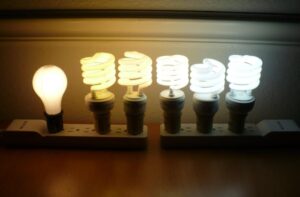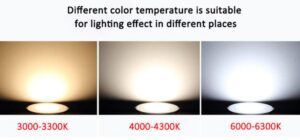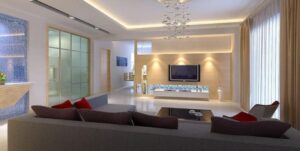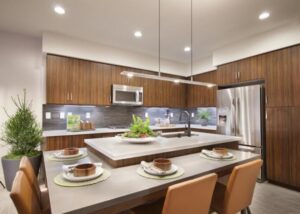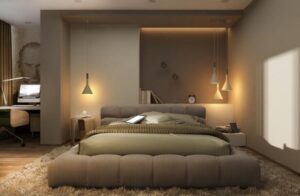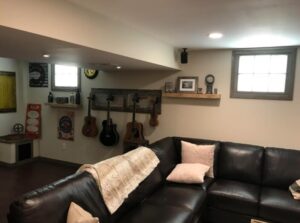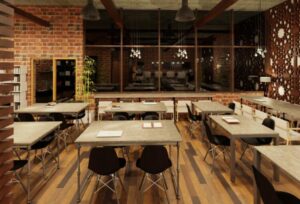LED bulbs have become quite popular over the previous years due to their brightness and energy conservation. However, LED lights generally come in various color temperatures whose suitability varies from room to room.
These color temperatures are typically measured using a Kelvin scale and labeled on the bulb’s box. However, though marked, you might end up buying an inappropriate color temperature if you are not aware of which color temperature is suitable for which setting.
As such, this article will walk you through:
- LED color temperature intro
- How to choose LED color temperature for different rooms?
- Soft white light vs. Daylight
Know terms before reading
1. What does color temperature mean?
Color temperature refers to the brightness you expect from a given bulb concerning its temperature measured in degrees Kelvin.
Unlike the typical manner in which you select bulbs using their wattage, where the higher the wattage, the brighter the bulb, in LED bulbs, color temperature is what you ought to consider.
LED bulbs with relatively lower color temperatures typically give off reddish-yellow hues, whereas those with higher color temperatures give off white-blue light.
Moreover, color temperature can at times referred to as the bulb’s Kelvin value.
2. What is Kelvin?
Kelvin is the unit through which we measure color temperature. Moreover, the Kelvin value of LED bulbs determines the shade of color it will give off, whether the warm yellow glow you get from incandescent bulbs or cooler colors.
What is the LED color temperature?
The selection of the best-LED color temperature varies depending on an individual’s requirements, as you will see in the article’s subsequent sections.
However, LED color temperatures typically fall into the below color temperature categories:
1. 2300K
The 2300K color temperature is a low color temperature that produces warm white lighting. The warm lighting makes the color temperature ideal for areas where calm and relaxed atmospheres are required.
However, 2300K color temperature is not conducive for a variety of activities like:
- shaving
- reading
- application of make-up
Hence, generally conducive for use in the living room and bedroom.
2. 2700K
The 2700K color temperature falls in the low color temperature classification and has similar drawbacks and advantages as the 2300K category.
However, unlike the former color temperature, the 2700K color temperature produces warm white lighting. The warm lighting makes the 2700K color temperature conducive for creating a homely tone in the living room and bedroom.
3. 3000K
The 3000k color temperature is the limit of the warm-colored lighting. similar to the earlier two creates a homely tone making it suitable for use in the bedroom and living room.
4. 4000K
The 4000K color temperature is high and results in daylight-like lighting that makes it suitable for lighting conservatories and garages.
The 4000K color temperature is also referred to as neutral or natural lighting by other brands.
5. 5000K
The 5000K color temperature is the limit of the daylight effect. Like the 4000K, the 5000K color temperature is conducive for use in the conservatories and garages, and dark office. The 5000K is usually also referred to as neutral or natural lighting.
6. 6000K
6000k is a high color temperature that gives off cool white light and tends to stimulate serotonin secretion.
Moreover, the bright lighting makes it suitable for use in areas that require bright lightings, such as in the bathrooms and kitchen.
How to choose LED color temperature for different rooms?
Just as the sun gives us energy, light bulbs to certain degrees also do the same. Installing bulbs that give off blue light waves produces serotonin making us alert, focused, and awake.
Conversely, bulbs that do not give off blue light waves stimulate the brain to produce melatonin that makes us; drowsy, relaxed, and sleepy.
As such, while selecting an appropriate color temperature for a room, consider the below:
Living Room
Living rooms are popular places to kick back, relax and entertain you and your guests. However, whether chatting with friends or watching movies, mix light sources in the living room to ensure you adapt readily to the occasions.
In the living room, you ought to avoid lamps that emit bright blue lights as these lights foster serotonin production resulting in higher energy levels. As such, you can direct adjustable spotlight lamps to walls to illuminate:
- Family photos
- Artworks
- Reduce glare on the television
Positioning spotlights lamps on walls and ceilings will help eliminate unwanted shadows.
Moreover, LED lights with a color temperature of 2200K to 3000k are suitable for living rooms because they foster melatonin production. Melatonin helps create a relaxed atmosphere in the living room.
If you have a television incorporated in your living room, you can create a theater-like atmosphere by installing LED pendants. LED pendants will mitigate shadow formations in the living room when you dim the lights.
Dining room/Kitchen
When the family gathers for a meal at the dining table, you do not want the lighting to be too bright. Moreover, you should ensure the lighting is not too dim that it results in people becoming drowsy.
Therefore, Installing LED lights with a color temperature of 2200 to 3000k will result in neutral to soft tones that create the perfect ambiance. Opting for LED chandelier bulbs is also a promising way to go as they offer beautiful color and light output.
However, when it comes to the kitchen, you should keep in mind that often, people start their days in the kitchen.
Therefore, it is advisable to install LED lights with a color temperature of 2700 to 5000K as they will emit blue light that will help keep you alert in the kitchen.
Moreover, settle on recessed can lights or a ceiling fixture that will evenly distribute light in the kitchen. For work spots, you can install overhead light fixtures such as under-cabinet lights for food prep areas.
If you have a table in the kitchen, installing dimmable overhead fixtures with warmer color temperatures can create a nice ambiance that will balance out the bright blue light.
Bedroom/Closet
When it comes to the bedroom, a calm, relaxed and peaceful atmosphere is what most people find ideal.
Installing LED light bulbs of color temperature 2700K to 3000K result in the production of non-blue light waves stimulating the brain to secrete melatonin hence a relaxed yet peaceful atmosphere.
Moreover, the light is not bright to the extent of tricking your mind into thinking that it is natural daylight, something that might affect your sleep patterns.
Selecting LED lights that give off neutral or soft blue lights is also applicable.
For the closet, you can install bulbs with color temperatures of about 3000K to match the rest of the bedroom to avoid sharp contrasts that are detrimental to your eye’s health.
Bathroom
Whether you are going to work, school, or any event, people tend to use the bathrooms to ensure they look as appealing as possible.
Ideally, it is advisable to have the lighting coming from around the mirror than from the ceiling.
However, the lighting has to be bright enough to ensure that you shave appropriately and make-up is also well applied.
Therefore, installing LED bulbs with color temperatures of 3000K to 5000K is recommended because they will provide the light that is bright enough to illuminate the entire bathroom, especially if globe-style bulbs are the incorporated bulbs.
Basement/Garage
Basements and garages typically tend to be crowded areas with numerous equipment and boxes of things people no longer use.
As such, while considering appropriate lighting for these rooms, installing LED bulbs with color temperatures ranging from 4000K to 5000K is recommended as they will offer the best illumination enabling anyone going into the basement or garage to safely and operate with ease in there.
Moreover, having a handheld LED torch that emits a bright light will enable you to access sections where the lighting is insufficient. Unless you intend on installing overhead LED bulbs in hard-to-reach places also.
General office, Break Room, Conference, Lobby
In the office sections, the selected lighting should foster maximum productivity.
Therefore, installing bright lights with color temperatures of 5000K-6000K will stimulate the brain to secrete serotonin which will help keep individuals in the above areas alert and focused, bolstering their productivity.
However, ensure you position the LED bulbs such that unwanted glares do not form, especially when using computers.
Moreover, installing LED desk lamps might help improve the lighting and individual productivity because they allow the user to adjust the color temperatures to suit the reader’s personal preferences. Not one shoe fits all scenarios.
However, when it comes to the lobby and break room, you should opt for warmer colors such as those produced by LED bulbs of lower color temperatures. Warmer colors foster the secretion of melatonin that will help the guests in the lobby feel welcomed.
In the break room, to enable the employees to release the tension they accumulate during the work, install low color light temperatures. The lower color temperatures will help them perform optimally once their shift resumes.
Reading and Study room
As in the case with Offices, reading and study rooms ought to be equipped with LED lights that have color temperatures about 4000K.
The stated color temperatures stimulate the secretion of serotonin. Serotonin will enable the reader to remain focused and alert during the reading process.
Moreover, incorporating LED desk lamps will enable the reader to adjust the color temperature to his or her liking. The adjustment will allow the reader to maximize his or her productivity.
Soft white light vs. daylight
Soft white light is light with a color temperature of 2700K to 3000K. Soft white lights tend to give off an orange glow.
As earlier stated, color temperatures ranging from 2700K to 3000K are suitable for use in relaxed rooms. Therefore, soft white light is conducive for use in bedrooms and living rooms. Soft white lights are also applicable in dining rooms.
Daylight is light whose color temperature ranges from 3000K to 5000K. Pure sunlight has a color temperature of about 5000K hence the name Daylight used in these bulbs.
As earlier stated, color temperatures of 3000K to 5000K are suitable for rooms where the people using them are required to be alert and focused, making daylight conducive for use in various rooms such as in the:
- Study room
- Garage
- Attic
- Basement
- Back, side, and front porch
- Home office
- Dining room
- Bathroom
- Kitchen
How to choose the suitable led color?
LED lights come in various colors ranging from warm white with orange glows to cool white with a blue appearance.
But what color should my LED lights be? You should consider the following factors:
1. The function of the room
If you will use the room for relaxing, then go for warmer colors. However, if you will use it for activities that require keenness, cool white colors will be best.
2. Paint color
Depending on the room’s painting, warm or cool lights will be best. However, ensure the lighting compliments the wall paint.
3. The room’s mood
The mood you are aiming to create for your room will determine the color you should set the LEDs to. If you want a homely mood go for LEDs with soft lights.
However, for rooms where you aim to create a sober atmosphere, LEDs classified as giving out neutral lights are conducive.
Conclusion
LED bulbs come in various color temperatures, as indicated above. These color temperatures are suitable for different activities like that using the wrong color temperature will result in undesirable effects.
Therefore, while selecting an appropriate color temperature for whichever purpose, ensure you follow the above guidelines.
However, if you find any challenges choosing a color temperature, settle for dimmable LED bulbs as you will be able to adjust the color temperature according to your needs.

